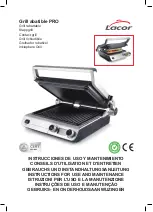
3.1. Air Supply
(Recommended hook-up is shown in fig. 1.)
3.1.1. Ensure drill air valve (or trigger) is in the "off" position before connecting to the air supply.
3.1.2. You will require an air pressure of 90psi and an air flow of 4.5cfm.
3.1.3.
WARNING!
Ensure the air supply is clean and does not exceed 90psi. Too high an air
pressure or unclean air will shorten the life of the drill due to excessive wear, and may
be dangerous, causing damage and/or personal injury.
3.1.4. Drain the air tank daily. Water in the air line will damage the drill.
3.1.5. Clean compressor air inlet filter weekly.
3.1.6. Line pressure should be increased to compensate for unusually long air hoses (over 8
metres). The minimum hose size should be 1/4” I.D. and fittings must have the same internal
bore.
3.1.7. Keep hose away from heat, oil and sharp edges. Check hose for wear and make certain
that all connections are secure.
3.2. Couplings
Vibration may cause failure if a quick change coupling is connected directly to the drill.
To overcome this, connect a leader hose to the drill. A quick change coupling may then be
used to connect the leader hose to the air line recoil hose. (See figs. 1 & 2).
3.
PREPARING DRILL FOR USE
4. OPERATING INSTRUCTIONS
WARNING! Ensure you read, understand and apply safety instructions before use.
4.1.
Take hold of the drill with one hand and wrap thumb and forfinger around the back part of
chuck. Spin front part of chuck anticlockwise with other hand to open the jaws to the size of
the drill bit to be used.
4.2.
Insert drill bit and rotate front part of chuck until it starts to grip the drill bit. Grip rear part of
chuck and turn front part of chuck clockwise until the bit is firmly locked in place. Rotate
whole chuck to check that bit is running true.
fig.1
Original Language Version
GSA27 Issue:3(SP)-31/07/13
fig.2
© Jack Sealey Limited






















